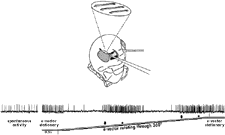
| Cricket POL-neurons | ||
1) POL-neurons in the optic lobe In the cricket Gryllus campestris several morphological classes of POL-neuron have been described. The data presented here refer to the best-studied POL1 class of neurons. |
|
more more |
E-vector tuning: There are three types of POL-neuron that exhibit maximal spike rates at different e-vector orientations, i.e. about 10°, 60° and 130° relative to the long axis of the head (Fig. 4). Each of these tuning types receives input from a large number of dorsal rim ommatidia of appropriate orientations (see Fig. 1) . The three signals from the three POL-neuron types may code the insect's orientation with respect to the celestial polarization pattern (see Models and robots). |
|
more |
Visual fields: The visual fields of the POL-neurons are > 60° wide and are directed to the upper part of the sky (Fig. 5). The large size of the visual fields results from (1) optical integration due to the large acceptance angles of the dorsal rim ommatidia (see Sensory input to insect POL-neurons) and (2) neural integration, since each POL-neuron receives input from a large number of dorsal rim ommatidia. Integrating polarization over a large area of the sky makes the POL-neurons insensitive to local obstructions of the polarization pattern due to clouds or tree canopies. |
|
more |
Morphological properties of cricket POL-neurons In the POL1 neuron, a dense array of dendritic branches occupies the dorsalmost part of the medulla, where it receives sensory input from the POL-area of the eye (Fig. 6). The photoreceptor axons probably do not contact the POL-neurons directly but via yet unknown interneurons. The axon runs all the way through the brain and branches in the contralateral medulla. This indicates that the e-vector detection systems of both sides interact which each other. |
more |
|
References: |
|
| 1 | Blum, M. and Labhart, T. (2000) Photoreceptor visual fields, ommatidial array, and receptor axon projections in the polarization-sensitive dorsal rim area of the cricket compound eye. J. Comp. Physiol. A 186, 119-128 |
| 2 | Labhart, T. (1988). Polarization-opponent interneurons in the insect visual system. Nature 331, 435-437. |
| 3 | Labhart, T. (1996). How polarization-sensitive interneurones of crickets perform at low degrees of polarization. J. Exp. Biol. 199, 1467-1475. |
| 4 | Labhart, T., Hodel, B. and Valenzuela, I. (1984). The physiology of the cricket's compound eye with particular reference to the anatomically specialized dorsal rim area. J. Comp. Physiol. A 155, 289-296. |
| 5 | Labhart, T. and Petzold, J. (1993) Processing of polarized light information in the visual system of crickets. In Sensory Systems of Arthropods (ed. K. Wiese, F. G. Gribakin, A. V. Popov and G. Renninger), pp. 158-168. Basel, Boston, Berlin: Birkhäuser Verlag. |
| 6 | Labhart, T., Petzold, J. and Helbling, H. (2001) Spatial integration in polarization-sensitive interneurons of crickets: a survey of evidence, mechanisms and benefits. J. Exp. Biol. 204:2423-2430. |
| 7 | Petzold, J. (2001) Polarisationsempfindliche Neuronen im Sehsystem der Feldgrille, Gryllus campestris: Elektrophysiologie, Anatomie und Modellrechnungen. PhD thesis, University of Zürich. |





